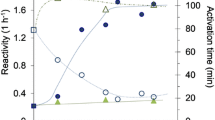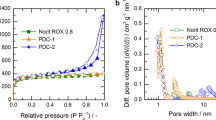Abstract
With using ordered mesoporous silica as a hard template, high surface area porous carbon materials were prepared when a chemical degradation of waste polyester beverage packaging was employed as a precursor, and it was characterized by X-ray diffraction, Brunauer–Emmett–Teller, scanning electron microscopy, and transmission electron microscopy. Polyester derived porous carbons were used as adsorbents to remove three typical organic pollutants, phenol, methylene blue, and 1-butyl-3-methylimidazolium chloride ([Bmim]Cl) from water. The effects of several parameters including contact time, adsorption temperature, and initial concentration were investigated via batch adsorption experiments. The adsorption kinetics fitted well with pseudo-second-order model and intraparticle diffusion mode. Furthermore, linear isotherm studies revealed better fitting of Langmuir model to adsorption data, and the estimated maximum monolayer adsorption capacity for phenol, methylene blue, and [Bmim]Cl was 675.7, 5298.6, and 341.3 mg/g, respectively.
Graphical Abstract











Similar content being viewed by others
References
Bucior BJ, Chen DL, Liu J, Johnson JK (2012) Porous carbon nanotube membranes for separation of H2/CH4 and CO2/CH4 mixtures. J Phys Chem C 116(49):25904–25910
Balgis R, Sago S, Anilkumar GM, Ogi T, Okuyama K (2013) Self-organized macroporous carbon structure derived from phenolic resin via spray pyrolysis for high-performance electrocatalyst. ACS Appl Mater Interfaces 5(22):11944–11950
Guo R, Yue W, An Y, Ren Y, Yan X (2014) Graphene-encapsulated porous carbon-ZnO composites as high-performance anode materials for Li-ion batteries. Electrochim Acta 135:161–167
Wang Y, Yao M, Chen Y, Zuo Y, Zhang X, Cui L (2015) General synthesis of magnetic mesoporous FeNi/graphitic carbon nanocomposites and their application for dye adsorption. J Alloys Compd 627:7–12
Jain A, Balasubramanian R, Srinivasan MP (2015) Production of high surface area mesoporous activated carbons from waste biomass using hydrogen peroxide-mediated hydrothermal treatment for adsorption applications. Chem Eng J 273:622–629
Mohd Din AT, Ahmad MA, Hameed BH (2015) Ordered mesoporous carbons originated from non-edible polyethylene glycol 400 (PEG-400) for chloramphenicol antibiotic recovery from liquid phase. Chem Eng J 260:730–739
Wu Q, Li W, Tan J, Nan X, Liu S (2015) Hydrothermal synthesis of magnetic mesoporous carbon microspheres from carboxymethylcellulose and nickel acetate. Appl Surf Sci 332:354–361
Elaigwu SE, Kyriakou G, Prior TJ, Greenway GM (2014) Microwave-assisted hydrothermal synthesis of carbon monolith via a soft-template method using resorcinol and formaldehyde as carbon precursor and pluronic F127 as template. Mater Lett 123:198–201
Zhang S, Dokko K, Watanabe M (2014) Direct synthesis of nitrogen-doped carbon materials from protic ionic liquids and protic salts: structural and physicochemical correlations between precursor and carbon. Chem Mater 26(9):2915–2926
Islam MA, Tan IAW, Benhouria A, Asif M, Hameed BH (2015) Mesoporous and adsorptive properties of palm date seed activated carbon prepared via sequential hydrothermal carbonization and sodium hydroxide activation. Chem Eng J 270:187–195
Njoku VO, Islam MA, Asif M, Hameed BH (2015) Adsorption of 2,4-dichlorophenoxyacetic acid by mesoporous activated carbon prepared from H3PO4-activated langsat empty fruit bunch. J Environ Manage 154:138–144
Girón RP, Gil RR, Suárez-Ruiz I, Fuente E, Ruiz B (2015) Adsorbents/catalysts from forest biomass fly ash. Influence of alkaline activating agent. Microporous Mesoporous Mater 209:45–53
Qiu J, Wang G, Bao Y, Zeng D, Chen Y (2015) Effect of oxidative modification of coal tar pitch-based mesoporous activated carbon on the adsorption of benzothiophene and dibenzothiophene. Fuel Process Technol 129:85–90
Acevedo B, Barriocanal C, Lupul I, Gryglewicz G (2015) Properties and performance of mesoporous activated carbons from scrap tyres, bituminous wastes and coal. Fuel 151:83–90
Carvalho MT, Agante E, Durao F (2007) Recovery of PET from packaging plastics mixtures by wet shaking table. Waste Manage 27(12):1747–1754
Chilton T, Burnley S, Nesaratnam S (2010) A life cycle assessment of the closed-loop recycling and thermal recovery of post-consumer PET. Resour Conserv Recycl 54(12):1241–1249
López-Fonseca R, Duque-Ingunza I, de Rivas B, Arnaiz S, Gutiérrez-Ortiz JI (2010) Chemical recycling of post-consumer PET wastes by glycolysis in the presence of metal salts. Polym Degrad Stab 95(6):1022–1028
Lorenc-Grabowska E, Diez MA, Gryglewicz G (2016) Influence of pore size distribution on the adsorption of phenol on PET-based activated carbons. J Colloid Interface Sci 469:205–212
Neves CM, Lemus J, Freire MG, Palomar J, Coutinho JA (2014) Enhancing the adsorption of ionic liquids onto activated carbon by the addition of inorganic salts. Chem Eng J 252:305–310
Yue QF, Wang CX, Zhang LN, Ni Y, Jin YX (2011) Glycolysis of poly(ethylene terephthalate) (PET) using basic ionic liquids as catalysts. Polym Degrad Stab 96(4):399–403
Zeng G, Liu Y, Tang L, Yang G, Pang Y, Zhang Y, Zhou Y, Li Z, Li M, Lai M, He X, He Y (2015) Enhancement of Cd(II) adsorption by polyacrylic acid modified magnetic mesoporous carbon. Chem Eng J 259:153–160
Nguyen ST (2014) Generalized Kelvin model for micro-cracked viscoelastic materials. Eng Fract Mech 127:226–234
Sangwichien C, Aranovich GL, Donohue MD (2002) Density functional theory predictions of adsorption isotherms with hysteresis loops. J Colloids Surf 206:313–320
Fu J, Chen Z, Wang M, Liu S, Zhang J, Zhang J, Han R, Xu Q (2015) Adsorption of methylene blue by a high-efficiency adsorbent (polydopamine microspheres): kinetics, isotherm, thermodynamics and mechanism analysis. Chem Eng J 259:53–61
Li W-H, Yue Q-Y, Gao B-Y, Ma Z-H, Li Y-J, Zhao H-X (2011) Preparation and utilization of sludge-based activated carbon for the adsorption of dyes from aqueous solutions. Chem Eng J 171(1):320–327
Guo W, Meng X, Liu Y, Ni L, Hu Z, Chen R, Meng M, Wang Y, Han J, Luo M (2015) Synthesis and application of 8-hydroxyquinoline modified magnetic mesoporous carbon for adsorption of multivariate metal ions from aqueous solutions. J Ind Eng Chem 21:340–349
Li L, Liu S, Zhu T (2010) Application of activated carbon derived from scrap tires for adsorption of Rhodamine B. J Environ Sci 22(8):1273–1280
Palomar J, Lemus J, Gilarranz MA, Rodriguez JJ (2009) Adsorption of ionic liquids from aqueous effluents by activated carbon. Carben 47:1846–1856
Atar N, Olgun A (2009) Removal of basic and acid dyes from aqueous solutions by a waste containing boron impurity. Desalination 249(1):109–115
Abramian L, El-Rassy H (2009) Adsorption kinetics and thermodynamics of azo-dye Orange II onto highly porous titania aerogel. Chem Eng J 150(2-3):403–410
Weber WJ, Morris JC (1963) Intraparticle diffusion during the sorption of surfactants onto activated carbon. J Sanit Eng Div Am Soc Civil Eng 89:53–61
Tao JH, Zhang F, Yue QF (2015) Magnetic mesoporous carbon: efficiently reusable adsorbent for ionic liquid [Bmim]Cl from aqueous solution. J Sol Gel Sci Technol 74(3):834–843
Mohammadi N, Khani H, Gupta VK, Amereh E, Agarwal S (2011) Adsorption process of methyl orange dye onto mesoporous carbon material-kinetic and thermodynamic studies. J Colloid Interface Sci 362(2):457–462
Konicki W, Cendrowski K, Bazarko G, Mijowska E (2015) Study on efficient removal of anionic, cationic and nonionic dyes from aqueous solutions by means of mesoporous carbon nanospheres with empty cavity. Chem Eng Res Des 94:242–253
Chen L, Bai B (2013) Equilibrium, kinetic, thermodynamic, and in situ regeneration studies about Methylene blue adsorption by the Raspberry-like TiO2@yeast microspheres. Ind Eng Chem Res 52(44):15568–15577
Acknowledgements
This work was financial supported by Pre-research fund for the Technology Development of Harbin Normal University (Supportion in 2015) and Doctor Funding of Harbin Normal University (No.XKB201310).
Author information
Authors and Affiliations
Corresponding author
Ethics declarations
Conflict of interest
The authors declare that they have no competing interests.
Rights and permissions
About this article
Cite this article
Yang, J., Jin, Y.X., Yu, X.P. et al. High surface area ordered mesoporous carbons from waste polyester: effective adsorbent for organic pollutants from aqueous solution. J Sol-Gel Sci Technol 83, 413–421 (2017). https://doi.org/10.1007/s10971-017-4419-7
Received:
Accepted:
Published:
Issue Date:
DOI: https://doi.org/10.1007/s10971-017-4419-7




